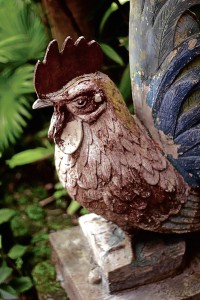
Architects face great pressure when designing their own home. Their houses give their potential clients a heads-up on their style; they’re a physical testimony of their skills as artists, which will either be permanently praised or scorned.
So how did champion of Philippine architecture Francisco “Bobby” Mañosa design his own home? Is the house an epitome of the Mañosa architectural trademark?
The Mañosa residence is a great take on what Filipino architecture truly is, at least according to the Mañosa book.
He said he was able to fully exercise his creative license: “The client was me and myself.”

The abode, completed in 1983, exhibits the beauty and uniqueness of Filipino architecture from every angle. But Mañosa pointed out that the house did not initially appeal to the public, as it would often be criticized for its “cheap construction.”
“People would say that materials such as bamboo and rattan were cheap building materials,” said Mañosa.
He added that the colonial mentality of the Filipinos would always favor the architecture from the West, ignoring its incompatibility with the Philippines’ tropical climate.
However, all these misconceptions were proven wrong, as some years later his home was featured in various publications here and abroad, and cited for its sustainable design, proving that “Filipino architecture” is not just a made-up style.
His home was even opened to tourists, students and design professionals for viewing, which gave them inspiration and insight on what vernacular architecture really was.
Filipino sophistication
The lower level of the house, called the zaguan, or multipurpose area, has a dominant rough adobe finish. Its upper level makes use of timber construction.
This stone-and-wood-based type of design is reminiscent of the bahay na bato (Filipino ancestral house), a traditional home during the era of Spanish colonization.
Two rooster sculptures adorn the staircase toward the entrance. The design is inspired by the Maranao people’s sarimanok (mythical bird).
“In India, they have elephants at their entrance; in China they have dragons; we have the sarimanok,” Mañosa said.
All the stairways in his home adhere to the tradition of oro, plata, mata (gold, silver, death)—a sort of Filipino geomancy.
In addition, Mañosa was able to hide all the columns, which enhances the openness of the house to the environment and to people.
From cheap to elegant
The champion of Filipino architecture has found a way to diminish the erratic perception on the style. He explained the perception was an affliction. But he said what had been viewed as cheap before was now considered elegant.
Ceilings crafted from woven bamboo, hardwood flooring, and walls accentuated with capiz shells and mother-of-pearl overlays are just some of the dominant features.
The banggerahan (dish-washing area) is made of stainless steel, with cupboards of laminated wood. It contains portraits of different crops arranged according to the song “Bahay Kubo.”
The kitchen also provides a good view of the front yard to allow helpers to anticipate incoming guests.
The playroom, which Mañosa calls the “jeepney room,” displays some of his grandchildren’s finger paintings and a giant jeepney-like furniture where all the toys are stored in its hood, while its passenger area doubles as a seating and sleeping area.
Environmentally responsive design
Even before green architecture became today’s vogue, Mañosa said he had always been incorporating environmentally responsive designs in the structures he made. The nature-abundant design of Mañosa’s home successfully blurs the line between outdoors and indoors.
Giving consideration to the country’s tropical climate, the living room’s double high-pitched roof has openings that allow warm air to exit the building. The open area of the house allows air to freely circulate.
Hanging in the middle of the living area is a large chandelier, designed to look like a hand of bananas.
Lush landscapes and water features also surround the Mañosa residence, which contributes to the passive cooling of the house, making electric fans and air-conditioning units virtually unnecessary.
The master’s bedroom contains a view of a fishpond, which not only gives the room a cooling effect but also a romantic view, as it is positioned in front of their bed.
“We actually catch some milkfish at the pond and cook it for dinner,” Mañosa said.
Mañosa has always been an advocate of Filipino architecture. Though materials are indigenous, current construction technology allows these to withstand the wear and tear of the elements and the years, he said.
But he lamented the current status of Philippine architecture. He said most Filipinos would rather reference Spanish villas, French chateaus and Mediterranean houses as inspirations for their dream homes. He said this lingering colonial mentality could erase our own architecture and national identity.
“If none of us [architects] will do Filipino architecture, then who else will?” he said.

